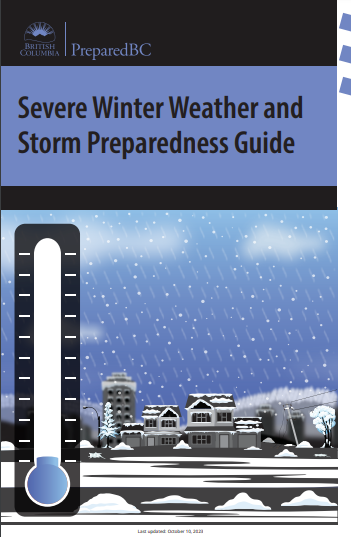AFTER a warm start to winter across much of the province, the Ministry of Emergency Management and Climate Readiness is encouraging British Columbians to prepare for colder weather and winter road conditions in the days and weeks ahead.
Environment and Climate Change Canada (ECCC) has forecast a return to seasonal, cooler temperatures and issued a series of snowfall and wind warnings for many regions of the province. People are encouraged to frequently check weather conditions and forecasts through ECCC for the latest updates.
Motorists throughout the province are urged to be prepared for changing road conditions and avoid unnecessary travel if conditions are bad.
People who use the backcountry for recreational activities are urged to be mindful of conditions and use extreme caution in mountainous terrain. Visit the Avalanche Canada website or mobile app to get the latest avalanche forecasts and learn more about staying safe from avalanches.
The Province has created a new multi-language winter-weather and storm-preparedness guide to help people get ready for severe winter weather. The guide is available in Punjabi, simplified and traditional Chinese, French and English on the PreparedBC website. The PreparedBC website also has tips and resources on how to prepare for the forecasted weather, including:
* Wear winter gear: Always wear clothing appropriate for the weather. Dressing in layers with a wind- and water-resistant outer layer provides flexibility for changing conditions. To avoid frostbite, cover as much exposed skin as possible by wearing hats, scarves and gloves. Try to stay dry and change out of wet clothing as soon as possible.
* Be prepared for power outages: Severe weather can cause power outages. Be prepared for up to one week by developing a household emergency plan and putting together an emergency kit. If you encounter a downed or damaged power line, assume it is live and a danger. Stay back at least 10 metres (the length of a bus) and call 911 immediately to report it.
* Winterize your home: Now is a good time to winterize your home by insulating walls and attics, weather-stripping doors and windows, clearing rain gutters and removing tree branches that could fall during windstorms.
For people who are driving, helpful tips for travelling in wet and winter driving conditions include:
* Review the current road conditions before you leave – @DriveBC (http://www.twitter.com/
* Nearly 900 highway webcam views are available at more than 450 locations throughout B.C.
* Check the weather forecast and consider postponing travel. If travel is necessary, wait until conditions improve.
* Wear comfortable clothing that does not restrict movement while driving. Bring warm clothing (e.g., winter boots, coat, gloves and hat) in case you need to get out of the vehicle.
* Have a vehicle emergency kit. Ensure your vehicle is equipped with a full tank of fuel or electrical charge, a windshield scraper and snow brush, food and water, a first-aid kit and other emergency supplies.
* Do not panic if you get stuck or stranded. Stay with your vehicle for safety and warmth.
* If you have a cellphone, call for roadside assistance. For emergencies, call 911.
The Ministry of Emergency Management and Climate Readiness works proactively with communities to ensure they have the supports and resources needed to protect people when extreme weather is forecast. The Province provides reimbursements to First Nations and local authorities for opening emergency warming centres during extreme weather. Warming centres help people warm up during cold weather and provide information about how to safely stay warm.
During cold weather, emergency warming centres and general warming space locations may be listed on EmergencyMapBC.ca at the discretion of First Nations and local authorities. If warming centres are not listed on the map in your area, contact your Band office or local authority for more information.
Emergency shelter spaces are also available through BC Housing for people in need of a warm, safe place to stay. This winter, the Province is funding more than 5,500 shelter spaces in 55 communities throughout the province, including permanent, temporary and extreme-weather response (EWR) shelters. EWR spaces open overnight when a community issues an extreme weather alert, such as during cold temperatures, snow or heavy rain. More shelter spaces will open this winter season as communities identify additional sites.
Learn More:
To find verified information during all partial and full-scale provincial emergencies, visit: https://www.emergencyinfobc.
Follow on X (Twitter): @EmergencyInfoBC
PreparedBC is a one-stop shop for emergency preparedness information. To view the new winter weather and storm guide, visit: https://www.preparedbc.ca/
Follow on Facebook: https://www.facebook.com/
Follow on X (Twitter): @PreparedBC
Follow on Instagram: @Prepared_BC
For information for communities about extreme cold and winter storm risks, visit: https://climatereadybc.gov.bc.
Environment and Climate Change Canada for up-to-date forecasts and alerts: http://www.weather.gc.ca
For weather forecasts and current road conditions, before leaving, check @DriveBC on X (Twitter) or visit: https://drivebc.ca/
For road advisories and information, visit: https://www.tranbc.ca/current-
For the latest avalanche forecasts from Avalanche Canada, visit: https://avalanche.ca
For winter driving tips, visit: https://www.shiftintowinter.ca (http://www.shiftintowinter.
For information about where to find indoor shelter spaces that are currently operating, visit BC Housing’s shelter map: https://smap.bchousing.org/
For what to include in a vehicle preparedness kit: https://www2.gov.bc.ca/gov/
